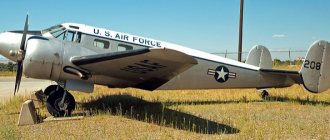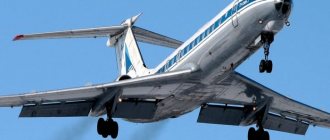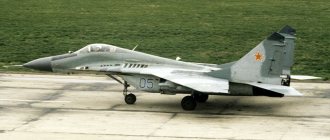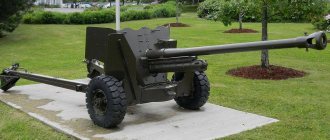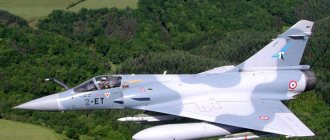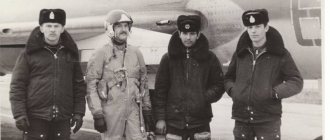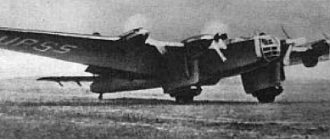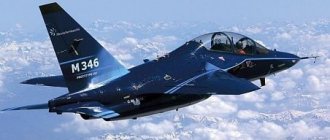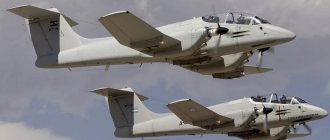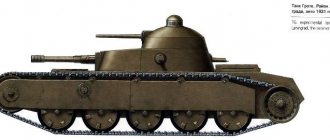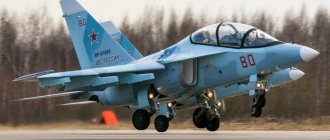Aviation of the USSR Armed Forces in the 80s.
Home » Books on the history of aviation » Aviation of the Armed Forces of the USSR in the 80s.
Aviation history booksReal history
John Adams 04/23/2020 5874
20
in Favoritesin Favoritesfrom Favorites 7
STRATEGIC AND LONG LONG BOMBERS.
Tu-160 supersonic strategic bomber-missile carrier, take-off weight 275 tons, length 54.1 m, wingspan 55.7/50.7/35.6 m, maximum thrust 4 x 18000 kgf, afterburner thrust 4 x 25000 kgf, maximum speed 2200 km/h, cruising speed 850 km/h, maximum range 13950 km, combat radius 7300 km, ceiling 16 km, crew 4, armament: 12 Kh-55 cruise missiles (or 24 Kh-15), bomb load up to 40 tons, start of operation 1987, by 1990 20 pieces a year.
Tu-95 strategic bomber-missile carrier, take-off weight 182 tons, length 46.9 m, wingspan 50 m, engine power 4 x 15000 hp, maximum speed 910 km/h, cruising speed 750 km/h, practical range up to 11000 km, combat radius 6340 km, ceiling 11.6 km, crew 9, armament: 3 x2 AM-23 guns, 3 KR X-22 (or 6 X-55), bomb load up to 11.8 tons, start of operation 1956, by 1990 175 things. Another 20 pieces were in the modification of the Tu-95RTS reconnaissance aircraft (in the Navy).
Tu-22M supersonic bomber-missile carrier, take-off weight 126 tons, length 42.5 m, wingspan 34.3/23.3 m, maximum thrust 2 x 14500 kgf, afterburner thrust 2 x 25000 kgf, maximum speed 2300 km/h, cruising speed 930 km /h, practical range 6800 km, combat radius 2410 km, ceiling 13.3 km, crew 4, armament: 1 (2) GSh-23 cannon, 3 KR X-22, bomb load up to 24 tons, start of operation 1976, by 1990 295 pieces (of which 120 are in the Navy). Another 20 pieces were in the modification of the Tu-22MR reconnaissance aircraft.
Tu-22 supersonic bomber-missile carrier, take-off weight 92 tons, length 42.6 m, wingspan 23.6 m, maximum thrust 2 x 11000 kgf, afterburner thrust 2 x 16500 kgf, maximum speed 1550 km/h, cruising speed 1000 (1300) km/h, practical range 5650 (2400) km, combat radius 2600 km, ceiling 13.5 km, crew 3, armament: R-23 cannon, 1 Kh-22 missile launcher, bomb load up to 9 tons, start of operation 1962, by 1990 135 pieces (of which 15 are in the Navy). Another 10 pieces in the modification of the Tu-22R reconnaissance aircraft (Navy).
Tu-16 long-range missile-carrying bomber, take-off weight 79 tons, length 34.8 m, wingspan 33 m, maximum thrust 2 x 9650 kgf, afterburner thrust 2 x 10650 kgf, maximum speed 1050 km/h, cruising speed 850 km/h , practical range 7200 km, combat radius 3150 km, ceiling 12.8 km, crew 6-7, armament: 7 x 23 AM-23 guns, 2 KSR-5 missiles, 1 K-10S missiles, bomb load up to 8.9 tons, start of operation 1954, by 1990 330 pieces (of which 190 were in the Navy). Another 170 units were in the modification of the Tu-16R reconnaissance aircraft (50 in the Navy). And 60 pieces were modified by the Tu-16N tanker aircraft (40 in the Navy).
FIGHTERS AND FIGHTER INTERCEPTORS.
Su-27 multi-role fighter (fighter-interceptor), take-off weight 21 (30) tons, length 18.5 (21.9) m, wingspan 12.7 (14.7) m, maximum thrust 2 x 7600 kgf, afterburner thrust 2 x 10300 (2 x 12500) kgf, maximum speed 2500 km/h, practical range 2400 (3900) km, combat radius 1680 km, ceiling 22.5 (18.5) km, crew 1, armament: GSh-30 cannon, 6 R-27 missiles, 6 R missiles -73, began operation in 1985, by 1990 there were 370 units (of which 160 in the air defense, 20 in the navy).
MiG-29 multi-role fighter, take-off weight 18.5 tons, length 17.3 m, wingspan 11.4 m, maximum thrust 2 x 5040 kgf, afterburner thrust 2 x 8300 kgf, maximum speed 2450 km/h, cruising speed 850 km/h, practical range 1430 km, ceiling 18 km, crew 1, armament: GSh-30 cannon, 6 R-60 missiles (2 R-27 missiles, 4 R-73 missiles), began operation 1984, by 1990 520 units (20 in the Navy ).
MiG-23 multi-role fighter, 20.1 tons, length 16.7 m, wingspan 7.8/14 m, maximum thrust 1 x 8550 kgf, afterburner thrust 1 x 13000 kgf, maximum speed 2500 km/h, practical range 1450 km, ceiling 17.7 km , crew 1, armament: 1 x 2 GSh 23 cannon, 4 R-24 and R-60 missiles, 2 Kh-23 missiles (or bombs up to 2 tons in total), began operation in 1969, by 1990 1835 pieces (of which 900 in air defense).
MiG-21 multi-role fighter, take-off weight 10.1 t, length 14.1 m, wingspan 7.2 m, maximum thrust 4100 kgf, afterburner thrust 6850 kgf, maximum speed 2230 km/h, cruising speed 1000 km/h, range 1225 km, ceiling 19 km, crew 1, armament: GSh-23 cannon, K-13 missiles, 16 ARS-57M missiles, 2 ARS-212, Kh-25 or Kh-66 missiles (or bombs up to 2 tons in total), began operation 1959 , by 1990, 510 pieces (of which 45 were in air defense). Another 50 pieces were in the modification of the MiG-21R reconnaissance aircraft.
MiG-25 fighter-interceptor, take-off weight 36.7 (41.2) tons, length 19.7 m, wingspan 14 m, maximum thrust 2 x 7500 kgf, afterburner thrust 2 x 11200 kgf, maximum speed up to 3000 km/h, practical range 1865 km, combat radius 770 km, ceiling 23 km, crew 1, armament: 4 R-60 or R-40 missiles, began operation in 1970, by 1990 375 units (of which 350 in air defense). Another 160 pieces were in the modification of the MiG-25R reconnaissance aircraft.
MiG-31 fighter-interceptor, take-off weight 46.7 tons, length 20.6 m, wingspan 13.5 m, maximum thrust 2 x 95000 kgf, afterburner thrust 2 x 15500 kgf, maximum speed up to 3000 km/h, cruising speed 950 (2500) km/h, practical range 1450 km, combat radius 720 km, ceiling 21.5 (up to 30) km, crew 2, armament: GSh-23M cannon, 4 R-33 missiles, 4 R-60 missiles, 2 R-40 missiles, began operation in 1981, by 1990 250 units (all in air defense).
Yak-28P fighter-interceptor, take-off weight 18.1 t, length 20 m, wingspan 11.8 m, maximum thrust 2 x 4690 kgf, afterburner thrust 2 x 6100 kgf, maximum speed 1850 km, range 2070 km, ceiling 14.5 km, crew 2, armament: GSh-23 cannon, R-8M missiles, began operation in 1960, by 1990 20 units (in air defense). Another 170 pieces were in the modification of the Yak-38R reconnaissance aircraft.
Tu-128 loitering interceptor, take-off weight 43.7 t, length 30.1 m, wingspan 17.5 m, maximum thrust 2 x 10100 kgf, maximum speed 1910 km/h, practical range 2565 km, ceiling 15.6 km, crew 2, armament: 2 missiles R-4R, 2 R-4T, start of operation 1965, end of operation 1990, by 1990 90 units (all in air defense).
Su-15 fighter-interceptor, take-off weight 17.9 tons, length 22 m, wingspan 9.3 m, maximum thrust 2 x 4100 kgf, afterburner thrust 2 x 6600 kgf, maximum speed 2230 km/h, practical range 1380 km, combat radius 725 km, ceiling 18.5 km, crew 1, weapons: UR 2xR-98M and 2xR-60M, bombs, up to 1.5 tons in total, began operation in 1965, by 1990 500 pieces (all in air defense).
MiG-19 fighter, take-off weight 8.8 tons, length 12.5 m, wingspan 9 m, maximum thrust 2 x 2600 kgf, afterburner thrust 2 x 3250 kgf, maximum speed 1452 km/h, practical range 1400 km, ceiling 15.6 km, crew 1, armament: 3 x NR-30 cannons, UR 4 RSU-2U, NUR 2-4 ORO-57 blocks, 2 x 250 kg bombs, start of operation 1955, end of operation 1989, a total of 6,500 pieces were produced.
FRONT BOMBERS, FIGHTER BOMBERS, STORM BOMBERS.
Su-24 front-line bomber, take-off weight 39.7 tons, length 24.6 m, wingspan 17.6/10.4 m, maximum thrust 2 x 7800 kgf, afterburner thrust 2 x 11200 kgf, maximum speed 1700 km/h, range 2775 km, combat radius 560 km, ceiling 11 km, crew 2, armament: 1x6 GSh 6-23 cannon, 2 R-60, 4 X-23, 3 X-59, 2 X-58 missiles, S-5 or S-8 unguided missiles or S-13, S-24 or S-25, bomb load up to 7 tons, start of operation in 1975, by 1990 930 units (of which 100 in the Navy). Another 165 units were in the modification of the Su-24MR reconnaissance aircraft (15 in the Navy).
Su-17 fighter-bomber, take-off weight 18.8 (19.7) tons, length 15.5, wingspan 13.7/10 m, maximum thrust 7800 kgf, afterburner thrust 11200 kgf, maximum speed 1860 km/h, range 2300 km, combat radius 1150 km, ceiling 15.4 km, crew 1, armament: 2 GSh-23 cannon, K-17 (R-60), Kh-23 (Kh-25, Kh-29), Kh-58 (Kh-27) missiles, unguided S-5 missiles (S-8, S-13), cluster bombs, total load up to 4 tons, start of operation in 1970, by 1990 900 pieces (of which 90 in the Navy). Another 135 pieces were in the modification of the Su-17R reconnaissance aircraft.
MiG-27 fighter-bomber, take-off weight 20.7 tons, length 17.1 m, wingspan 7.4/13.8 m, maximum thrust 8260 kgf, afterburner thrust 12540 kgf, maximum speed 1885 km/h, range 2500 km, combat radius 780 km, ceiling 14 km, crew 1, weapons: GSh-6-30 cannon, R-60 (R-13), Kh-23 (Kh-25, Kh-29), Kh-31 (Kh-27) missiles, unguided missiles S-5 (S-8, S-13), cluster bombs, total load up to 4 tons, began operation in 1975, by 1990 855 units.
Su-25 attack aircraft, take-off weight 17.6 tons, length 15.4 m, wingspan 14.4 m, maximum thrust 2 x 4100 kgf, maximum speed 950 km/h, cruising speed 750 km/h, range 1950 km, combat radius 650 km, ceiling 10 km, crew 1, armament: GSh-30-2 cannon, 2 R-60, 4 X-25 or 2 X-29 missiles, S-5 (S-8, S-13), S-24 ( S-25), bomb load up to 4 tons, start of operation 1981, by 1990 350 units.
Yak-38, Yak 38M carrier-based attack aircraft, take-off weight 11.3 (11.8) t, length 16.4 m, wingspan 4.5/7 m, maximum thrust 6100 (6700) kgf, maximum speed 1280 km/h, range 1300 km, ceiling 12 km , crew 1, weapons: VSPU-36 cannon, X-23 (X-25) missiles, S-5 (S-8), S-24 unguided missiles, aerial bombs, total load up to 1 ton, start of operation 1977, to In 1990, about 150 pieces (all in the Navy).
Su-7B fighter-bomber, take-off weight 13 tons, length 16.6 m, wingspan 9.3 m, maximum thrust 6800 kgf, afterburner thrust 9600 kgf, maximum speed 2120 km/h, cruising speed 786 km/h, practical range 1130 km , ceiling 15 km, crew 1, armament: 2 x NR-30 cannon, K-13 missile launcher (R-60, R-73), S-3 NUR (S-5, S-24), X-27 missiles ( X-57), bombs, total load up to 2 tons, start of operation 1960, end of operation 1986, a total of 1848 pieces were produced, in the 80s there were more than 300.
L-39 combat training aircraft (Czechoslovakia), take-off weight 4.7 t, length 12.1 m, wingspan 9.5 m, maximum thrust 2 x 1720 kgf, maximum speed 760 km/h, cruising speed 390 km/h, maximum range up to 1000 km, ceiling 11.5 km, crew 2, weapons (possible): UR 2+2, NUR 2+32, bombs 2x246 kg, start of operation 1970, by 1990 2080 pieces.
ANTI-SUBARINE AIRCRAFT.
Il-38 anti-submarine aircraft, take-off weight 68 tons, length 40.1 m, wingspan 37.4 m, engine power 4 x 4250 hp, maximum speed 650 km/h, combat radius 2200 km, ceiling 8 km, crew 7, weapons : 2 AT-1 (AT-2) anti-submarine torpedoes or APR-1 (APR-2, APR-3) missiles, anti-submarine bombs, up to 8.4 tons in total, began operation in 1969, by 1990 at least 60 pieces (all in the Navy) .
Tu-142 anti-submarine aircraft, take-off weight 185 tons, length 51.6 m, wingspan 50.2 m, engine power 4 x 15000 hp, maximum speed 855 km/h, cruising speed 720 km/h, combat radius 5200 km, ceiling 13.5 km, crew 10, armament: anti-submarine torpedoes AT-1 (AT-2), anti-submarine missiles AR-1 (APR-2, APR-3), anti-submarine bombs, began operation in 1972, in total by 1990 about 60 pieces (all in Navy).
Be-12 anti-submarine amphibious aircraft, take-off weight 36 tons, length 30.1 m, wingspan 30.2 m, engine power 2 x 5180 hp, maximum speed 550 km/h, maximum range 4000 km, combat radius 650 km, ceiling 12.1 km, crew 4, weapons: anti-submarine bombs and torpedoes up to 3 tons in total, began operation in 1965, by 1990 about 100 pieces (all in the Navy).
RADIO-ELECTRONIC INTELLIGENCE AND AWACS AIRCRAFT.
Il-20/22 electronic reconnaissance aircraft, take-off weight 64 tons, length 35.9 m, wingspan 37.4 m, engine power 4 x 4252 hp, maximum speed 685 km/h, cruising speed 625 km/h, practical range 6500 km, ceiling 10 km, crew 11, production started in 1968, by 1990 35 pieces (of which 5 in the Navy).
A-50 AWACS and control aircraft, take-off weight 190 tons, length 48.3 m, wingspan 50.5 m, maximum thrust 4 x 12000 kgf, cruising speed 800 km/h, practical range 7500 km, ceiling 12 km, crew 5+10, began operation in 1985, by 1990 there were 14 units (all in air defense).
Tu-126 AWACS aircraft, take-off weight 171 tons, length 54.1 m, wingspan 51.1 m, engine power 4 x 15000 hp, maximum speed 790 km/h, cruising speed 700 km/h, practical range 7000 km, ceiling 10.7 km, crew 6+12, start of operation 1965, by 1990 3 units (all in air defense).
refueling and transport aircraft.
3MS-2, 3MN-2 tanker aircraft, take-off weight 193 t, length 48.8 m, wingspan 53.1 m, maximum thrust 4 x 8700 (9500) kgf, maximum speed 930 km/h, practical range 9650 km, ceiling 12.7 km , crew 7, in the early 70s they were converted into tankers from 3M and M-4 strategic bombers, by the end of the 80s there were 40 of them.
IL-76 transport aircraft, take-off weight 210 tons, load capacity 60 tons, length 46.6 m, wingspan 50.5 m, maximum thrust 4 x 12300 kgf, maximum speed 950 km/h, cruising speed 750 km/h, flight range without cargo 9700 km, with a load of 4000-8500 km, ceiling 11.2 km, crew 5, start of operation 1974, by 1990 385 units. Another 14 units in the modification of the Il-78 tanker aircraft.
An-124 transport aircraft, take-off weight 392 tons, load capacity 120 tons, length 69.1 m, wing span 73.3 m, maximum thrust 4 x 23430 kgf, maximum speed 865 km/h, cruising speed 800 km/h, range 4800-7500 km , ceiling 11.6 km, crew 8, start of operation 1987, by 1990 12 units.
An-22 transport aircraft, take-off weight 225 tons, load capacity 60 tons, length 57.3 m, wingspan 64.4 m, engine power 4 x 15265 hp, maximum speed 650 km/h, cruising speed 560 km/h, practical range 5225 km, ceiling 9 km, crew 5-7, start of operation 1969, by 1990 55 units.
An-12 transport aircraft, take-off weight 61 tons, load capacity 21 tons, length 33.1 m, wingspan 38 m, engine power 4 x 4250 hp, maximum speed 660 km/h, cruising speed 570 km/h, flight range 5530 km, crew 5, armament: 2x23 mm cannon, bombs, began operation in 1959, by 1990 140 pieces (15 in the Navy). Another 15 pieces were in the reconnaissance aircraft modification (all in the Navy).
An-26 transport aircraft, take-off weight 24 tons, load capacity 5.5 tons, length 23.9 m, wingspan 29.2 m, engine power 2 x 2820 hp, maximum speed 540 km/h, cruising speed 435 km/h, practical range 1100 km, ceiling 7.3 km, crew 6, armament: bombs up to 500 kg, began operation in 1973, a total of about 500 units entered the Armed Forces (most of them in the army aviation, 30 in the Navy).
An-72 transport aircraft, take-off weight 32 tons, load capacity 7.5 tons, length 28.1 m, wingspan 31.9 m, engine thrust. 2 x 6500 kgf, maximum speed 720 km/h, cruising speed 600 km/h, practical range 2700 km, ceiling 10.1 km, crew 5, armament: container with GSh-23 cannon, bombs 100 kg, start of operation 1982, total 1990 about 30 pieces.
HELICOPTERS.
Mi-24 attack helicopter, take-off weight 11.5 tons, load capacity 2.4 tons, length 17.5 m, width 1.7 m, engine power 2 x 2500 hp, maximum speed 335 km/h, cruising speed 270 km/h, practical range 450 km, ceiling 5 km, crew 3, weapons: 2 containers with 12.7 mm or 7.62 mm machine guns or 23 mm cannons, NUR S-5, S-8, UR Shturm-V, Igla-S missiles, bombs up to 500 kg, accepted entered service in 1971, a total of 3,500 were produced.
Mi-8 multi-purpose helicopter, take-off weight 13 tons, length 25.3 m, engine power 2 x 1900 hp, maximum speed 270 km/h, cruising speed 240 km/h, practical range 580 km, ceiling 5.5 km, crew 3 , armament: 2 12.7 mm machine guns, 2 7.62 mm machine guns, 2 23 mm cannons, 8 NUR S-8 or Sturm-V, Igla-S or 4 bombs of 250 kg, landing 24, adopted in 1965, a total of 12,000 produced .
Mi-6 multi-purpose helicopter, take-off weight 42 tons, length 33.2 m, width 3.2 m, engine power 2 x 5500 hp, maximum speed 300 km/h, cruising speed 250 km/h, practical range 1450 km, ceiling 4.5 km, crew 5, put into service in 1963, a total of 926 were produced.
Mi-26 multi-purpose helicopter, take-off weight 56 tons, load capacity 20 tons, length 40 m, engine power 2 x 11400 hp, maximum speed 295 km/h, cruising speed 265 km/h, flight range up to 800 km, ceiling 4.6 km, crew 5, troops 82, put into service in 1980, a total of 318 were produced.
Ka-27 anti-submarine helicopter, take-off weight 12 tons, length 12.2 m, engine power 2 x 2225 hp, maximum speed 291 km/h, cruising speed 118 km/h, range up to 1000 km, ceiling 3.5 km, armament: 1 torpedo or missile-torpedo AT-1 (VTT-1, UMGT-1, APR-2), 8 bombs, total load up to 2 tons, crew 3, put into service in 1980, a total of 267 pieces were produced.
Ka-25 anti-submarine helicopter, take-off weight 7.1 t, length 9.8 m, engine power 2 x 900 hp, maximum speed 220 km/h, cruising speed 185 km/h, practical range 450 km, ceiling 4.5 km, armament: combat load 1.1t, crew 2, put into service in 1971, a total of 460 were produced.
Ka-29 shipborne transport and combat helicopter, take-off weight 11.5 t, length 12.2 m, engine power 2 x 2250 hp, maximum speed 280 km/h, cruising speed 235 km/h, practical range 460 km, ceiling 4.3 km , crew 2, landing force 16, armament: machine gun 7.62 (additional 2 guns GSh-23, NAR S-5 or S-8, Sturm-V missiles, 2 bombs), production 1984-91, a total of 59 pieces were produced.
Mi-14 multi-purpose amphibious helicopter, take-off weight 14.5 t, length 18.3 m, engine power 2 x 2000 hp, maximum speed 230 km/h, cruising speed 210 km/h, practical range 800 km, ceiling 4 km, crew 4, armament: combat load up to 2 tons, put into service in 1976, a total of 273 were produced.
Mi-2 multi-purpose helicopter, take-off weight 3.7 t, length 11.4 m, engine power 2 x 400 hp, maximum speed 210 km/h, cruising speed 194 km/h, practical range 580 km, ceiling 4 km, crew 1 , armament: NS-23 cannon, 2 (up to 6) machine guns, NAR S-5, adopted for service in 1964, a total of 5,400 were produced.
The USSR Air Force in the 80s consisted of: Long-range aviation: 30th Army (2 divisions, Irkutsk), 37th Army (4 divisions, Moscow), 46th Army (4 divisions, Smolensk); Front-line aviation: 16th Army GSVG (5 divisions), 4th Army SGV (3 divisions), 36th Army SouthGV, TsGV (2 divisions), 5th Army OVO (1 division), 15th Army PBVO (1 division), 26th Army BVO (2 divisions), 17th Army KVO, 14th Army PKVO (2 divisions), 34th Army WKVO (2 divisions), 73rd Army SAVO (2 divisions), 49th Army TVO (2 divisions), 76th Army LVO, 23rd Army ZBVO (4 divisions) , 1st Army of the Far Eastern Military District (4 divisions), 24th Army of the Supreme High Command (3 divisions), Air Force of the Moscow Military District (1 division); Military transport aviation: 6 divisions; (total 186 regiments, 50 divisions). The Ground Forces (50 helicopter regiments and 60 separate squadrons), Air Defense (74 regiments) and the Navy (45 regiments, 6 divisions) also had their own aviation.
In the second half of the 80s, many interesting aircraft models were developed, which went (or did not go) into series already in the 90s in the new Russia:
Su-27M multi-role fighter, modernization of the Su-27, first flight 1988, project closed in the second half of the 90s.
Su-27K carrier-based fighter, entered service in 1988, serial production since 1990.
Su-30 multirole fighter, first flight 1988, serial production since 1992.
Su-25T attack aircraft, modernization of the Su-25, first flight 1984, serial production 1990-91.
Su-34 fighter-bomber, first flight 1990, entered service in the 21st century.
MiG-29M multi-role fighter, modernization of the MiG-29, first flight 1986, project closed in the second half of the 90s.
MiG-29K carrier-based fighter, first flight 1982, in the 90s the program was frozen and resumed in 1999.
Yak-141 carrier-based attack aircraft, first flight 1987, project closed in 1992.
Il-102 attack aircraft, first flight 1982, project closed in 1987.
A-40 (Be-42) multi-purpose amphibious aircraft, first flight 1986, project closed.
An-71 AWACS aircraft, first flight 1985, program suspended in 1990.
Ka-50 attack helicopter, first flight 1982, entered service 1995.
Story
Officially, the beginning of the existence of the Russian Air Force is considered to be 1904, when the first aerodynamic institute was opened in the city of Kuchino, the head of which was Zhukovsky, one of the creators of aerodynamics in general. Flight schools were opened throughout the country during these years, and already in 1910 the Imperial Air Force was created, which disappeared only after the October Revolution of 1917.
Aviation of the Russian Empire actively defended the country's air borders during the First World War. At the same time, the state’s technology was not at the highest level, and most of the aircraft were created at foreign factories. However, Russia did not lag behind its competitors. For example, by 1915, domestic engineers brought to life the idea of creating a multi-engine bomber, which was named “Ilya Muromets”.
At the time of the First World War, Russian aviation was developing, both the navy and the army had their own aircraft and other aircraft.
Initially, domestic aircraft performed reconnaissance missions, but soon fighters began to be used that took part in air battles. They also began to achieve success in them: the author of the first aerial ram was the pilot Nesterov, who also distinguished himself by performing a loop. After the change of power, great attention was also paid to the development of aviation technology, which ten years later made it possible for the USSR to become a member of the club of the most powerful aviation states on the planet.
Aviation-related educational institutions were opened, talented aircraft designers appeared, and new aircraft models were developed.
Before the Great Patriotic War, USSR aviation rose to a qualitatively new level, new models of military aircraft were produced.
At the same time, at the beginning of the war, the aviation of the Soviet Union suffered defeat after defeat due to the fact that the pilots lacked professionalism, and the German machines were of higher quality. By 1943, the advantage in air battles passed to domestic aviation. German forces began to decline, and Soviet specialists mastered new methods of creating aircraft. The Great Patriotic War claimed the lives of twenty-seven thousand domestic pilots.
During the Cold War, aviation development also received increased attention. In the USSR, new models of military aircraft were developed, such as the Mig-29, Su-27. The situation changed with the collapse of the USSR, when the Air Force, like other military structures, was divided between individual republics.
Officially, the Russian Air Force has existed since 1997. This structure is constantly updated with new transformations, and also takes part in international conflicts.
Attention is paid to pilot training, number of flight hours, professional education and experience of military personnel.
The direct leadership of the air force is exercised by the head of the military space forces of the Russian Federation, Sergei Surovikin.
The Air Force includes not only aviation units, but also other structures: medical, meteorological, logistics and others.
The main commands of the Russian Air Force are located in cities such as Novosibirsk, Khabarovsk, St. Petersburg and Rostov-on-Don.
Interesting facts about the Russian Air Force
The commander of the Russian Air Force since 2015 is Lieutenant General Andrei Yudin.
According to the Russian Ministry of Defense, over the current decade the number of flight hours of the department's pilots has increased. Every year this figure increases by several percent.
This department is now in service with a huge number of aircraft, including Su-27, Su-30, Su-35 fighters, supersonic bombers Tu-160, Su-24.
The Air Force of the Russian Federation carries out a lot of important strategic tasks every day: they monitor the inviolability of the air and space borders of the state, take part in international conflicts, one of the parties to which is the Russian Federation, and also participate in various kinds of parades of military equipment, in particular on the Day Victory.
The department's forces are constantly being modernized and undergoing changes. The government and the Ministry of Defense are carrying out reforms and measures aimed at improving the functioning of the structure (for example, the 2008 reform). Aviation equipment is replenished with the latest combat units, which are immediately tested and put into use.
Russian Air Force symbols
As for the symbols of the air force, the department's chevron has a shield shape. Certain objects are depicted on a blue background, depending on which department the individual employee belongs to. The Obtex sewing production is engaged in professional embroidery of chevrons; if you wish, you can order Russian Air Force chevrons for the required number of people on the official website of our production.
In addition, the Russian Air Force has a special distinctive sign. This is a red star, which is framed by red and white lines. The same symbols, albeit slightly larger, have been used by the USSR Air Force since 1943. The Belarusian Air Force has a similar sign.
The flag of the Russian Air Force depicts half-wings of aircraft crossing each other, flanked by bird wings. This is all against a background of blue and yellow stripes, interspersed.
Structure of the air force of the Russian Air Force
Today, the Russian Air Force is part of the military space forces, the decree on the creation of which was published in August 2022. The leadership of the Russian Aerospace Forces is exercised by the General Staff of the RF Armed Forces, and direct command is exercised by the Main Command of the Aerospace Forces. The commander-in-chief of the Russian military space forces is Colonel General Sergei Surovikin.
The Commander-in-Chief of the Russian Air Force is Lieutenant General Yudin, he holds the position of Deputy Commander-in-Chief of the Russian Aerospace Forces.
In addition to the air force, the Aerospace Forces include space forces, air defense and missile defense units.
The Russian Air Force includes long-range, military transport and army aviation. In addition, the Air Force includes anti-aircraft, missile and radio technical troops. The Russian Air Force also has its own special troops, which perform many important functions: provide reconnaissance and communications, engage in electronic warfare, rescue operations and protection against weapons of mass destruction. The Air Force also includes meteorological and medical services, engineering units, support units and logistics services.
The basis of the structure of the Russian air force are brigades, air bases and commands of the Russian Air Force.
Four commands are located in St. Petersburg, Rostov-on-Don, Khabarovsk and Novosibirsk. In addition, the Russian Air Force includes a separate command that manages long-range and military transport aviation.
As mentioned above, the Russian Air Force is second only to the US Air Force in size. In 2010, the strength of the Russian air force was 148 thousand people, about 3.6 thousand different pieces of aircraft were in operation, and about 1 thousand more were in storage.
After the 2008 reform, air regiments turned into air bases; in 2010, there were 60-70 such bases.
Prospects for the Russian Air Force
Work is currently underway on the creation of several aircraft, some of them are in the final stages.
The main new product, which should soon enter service with the Russian Air Force and significantly strengthen it, is the Russian T-50 fifth-generation front-line aviation complex (PAK FA). The aircraft has already been shown to the general public several times, and prototypes are currently being tested. Information appeared in the media about problems with the T-50 engine, but there was no official confirmation of this. The first T-50 aircraft should enter service in 2021.
Among the promising projects, it is also worth noting the Il-214 and Il-112 transport aircraft, which should replace the outdated Anas, as well as the new MiG-35 fighter, they plan to begin delivering it to the troops this year.
In the near future, new machines are planned to be supplied to the troops and helicopter manufacturers: the Mi-38 and Ka-60 are undergoing the final stages of testing.
Work has begun on the creation of a new Russian “strategist” (PAK-DA), but it is likely that we will see it only after 2021.
